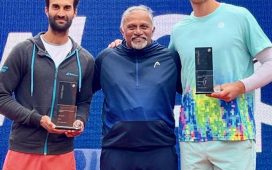Moments after an exhausted Sara Errani completed her first tennis match in five long months, instinct took over. As she hobbled back to her chair, the former world No 4 did what she has done in most of her 959 career matches, tearing off her wristband then tossing it to a young fan in the socially distanced crowd. To her right, the umpire visibly cringed and held her face in her hands, a picture of dismay.
This week professional tennis returned at a small women’s event in Palermo after months of cancellations. It stands as a first look at how the sport can function in this new reality and, in an individual sport where players are their own authorities, how willingly the players will follow the rules.
The results have been fascinating, particularly underlining the diversity of the perspectives involved. While Errani immediately apologised, a day later the 19-year-old Kaja Juvan committed the same faux pas. She shrugged off the umpire’s advice and then afterwards displayed some measure of unfamiliarity about the incubation period of the virus: “Obviously, we get tested a lot so I understand their concern … But all of us that are here are negative, I got the [test] result again today so I thought: ‘OK well I might as well give it to them,’” the Slovenian said.

Having already reduced its total prize money from $220k to $202k in order to function, Palermo is losing money by hosting the event without a full crowd, and it does not have the financial heft to enforce a strict bubble. Players are tested every four days and are regulated to travel with only one team member, but otherwise the WTA has advised players just to remain in their hotels and away from the population.
At the beginning of the event, Donna Vekic, who competed at the ill-fated Adria Tour and is a member of the WTA player council, casually admitted she had been going to dinner in town. Others are operating with more prudence. “I think there is no secret here,” said the top seed, Petra Martic. “We are just trying to stay out of the outside world. Just keep it club and hotel. And anyway, once the tournament starts you’re busy, so now that I’m playing you don’t really feel the difference from how it used to be.”

The tennis season is uniquely draining as players travel the globe for up to 11 months with a fleeting off-season. With the physical and mental baggage that builds over time, long-term injuries and breaks often actually yield positive outcomes. They force players to finally take a breather and step into the real world, offering greater perspective when they return. The Belarusian Aliaksandra Sasnovich has found a similar silver lining after five months away from tennis.
“I wished about this break for two years!” she said. “I needed time for two, three months to live a normal life. I had this time and I used it to the maximum, 100%. For someone it’s probably a problem they didn’t play tournaments. For me, I was happy not to play tournaments for four or five months.”
The global nature of tennis means each player will converge in the same venues having experienced completely different circumstances. Belarus is a prime example: it continued as normal during Europe’s shutdown while its authoritarian president, Alexander Lukashenko, claimed that vodka could cure coronavirus.
Sasnovich spent her time speaking with elders in her boyfriend’s village in the midst of a 20-week fitness block: “I really enjoyed every day I spent there. I woke up at 7 o’clock, just to go there, meet the people, to eat good food, to eat the desserts, to eat Nutella every day. I bought each week, Nutella, 750 grams. I finished the bottle very fast. I said: ‘Please don’t touch, this is mine, this is Sasha’s Nutella.’”
On court, the upsets that littered the field underlined how unpredictable the coming months could be and how much both WTA and ATP Tours could shift as some players unexpectedly round into form while others struggle to rediscover their level.

“I do feel there is an opportunity for everyone, I just feel like who’s gonna grab it? That’s the key,” said the world No 22, Anett Kontaveit.
The results speak volumes. Errani is ranked 169 and has struggled badly since her doping ban ended in 2018. She described the “ghosts inside” that led to a severe mental block on her serve, culminating in her frequently serving underarm last year. This week she reached the quarter-finals playing her best tennis in years. Likewise, Sasnovich had fallen 60 ranking places this season, but in Palermo she reached her first quarter-final since January 2019.
“We don’t know who was practising hard, who was not, who was more relaxed. And then we’ll see … in a few months you will see. I’m sure the rankings will change soon,” said Sasnovich. Then she laughed. “And mine as well.”








